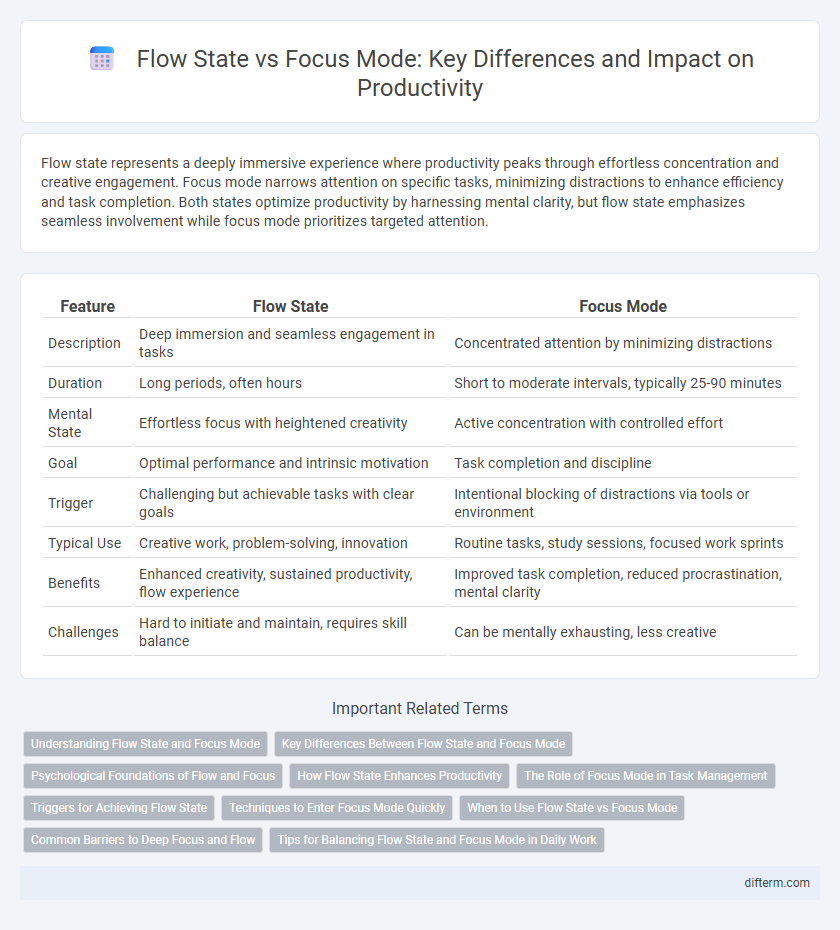Flow state represents a deeply immersive experience where productivity peaks through effortless concentration and creative engagement. Focus mode narrows attention on specific tasks, minimizing distractions to enhance efficiency and task completion. Both states optimize productivity by harnessing mental clarity, but flow state emphasizes seamless involvement while focus mode prioritizes targeted attention.
Table of Comparison
| Feature | Flow State | Focus Mode |
|---|---|---|
| Description | Deep immersion and seamless engagement in tasks | Concentrated attention by minimizing distractions |
| Duration | Long periods, often hours | Short to moderate intervals, typically 25-90 minutes |
| Mental State | Effortless focus with heightened creativity | Active concentration with controlled effort |
| Goal | Optimal performance and intrinsic motivation | Task completion and discipline |
| Trigger | Challenging but achievable tasks with clear goals | Intentional blocking of distractions via tools or environment |
| Typical Use | Creative work, problem-solving, innovation | Routine tasks, study sessions, focused work sprints |
| Benefits | Enhanced creativity, sustained productivity, flow experience | Improved task completion, reduced procrastination, mental clarity |
| Challenges | Hard to initiate and maintain, requires skill balance | Can be mentally exhausting, less creative |
Understanding Flow State and Focus Mode
Flow state is a psychological condition where one experiences complete immersion and heightened creativity during tasks, often resulting in optimal productivity and satisfaction. Focus mode, in contrast, emphasizes minimizing distractions to maintain sustained attention and efficient task completion. Understanding the differences between flow state and focus mode helps individuals tailor their work habits for maximum efficiency and enhanced cognitive performance.
Key Differences Between Flow State and Focus Mode
Flow state is characterized by complete immersion and effortless concentration on a task, often accompanied by a sense of time distortion and intrinsic enjoyment. Focus mode involves deliberate attention and minimized distractions to enhance productivity on specific tasks, typically requiring conscious effort to maintain. The key difference lies in flow state's automatic engagement and sense of ease, compared to focus mode's intentional control and sustained concentration.
Psychological Foundations of Flow and Focus
The psychological foundation of flow involves complete immersion in a challenging activity, where skill level aligns with task difficulty, leading to deep engagement and intrinsic motivation. Focus mode relies on directed attention and cognitive control, enabling suppression of distractions to maintain concentration on a specific task. Both states enhance productivity by optimizing mental resources, but flow uniquely triggers positive emotions and a sense of time distortion, driven by neurochemical changes in dopamine and norepinephrine pathways.
How Flow State Enhances Productivity
Flow state significantly enhances productivity by enabling individuals to achieve deep immersion and sustained concentration on tasks, which leads to higher efficiency and quality output. This mental state aligns challenge with skill level, fostering intrinsic motivation and reducing susceptibility to distractions, thereby accelerating task completion. Researchers find that flow optimizes cognitive resources, facilitating creativity and problem-solving, crucial for peak performance in demanding work environments.
The Role of Focus Mode in Task Management
Focus Mode enhances task management by minimizing distractions and allowing deeper concentration on specific activities, significantly improving efficiency and output quality. This mode helps prioritize tasks by creating a structured environment where interruptions are limited, facilitating a sustained progression through complex projects. By fostering continuous engagement, Focus Mode supports better time allocation and goal achievement within productivity workflows.
Triggers for Achieving Flow State
Flow state triggers include clear goals, immediate feedback, and a balance between challenge and skill level, which together create optimal conditions for deep immersion. Focus mode, while enhancing concentration, often lacks the dynamic feedback loop essential for sustaining flow. Cultivating an environment with minimal distractions, structured tasks, and intrinsic motivation significantly increases the likelihood of entering a flow state during productive work.
Techniques to Enter Focus Mode Quickly
Techniques to enter focus mode quickly include minimizing digital distractions by turning off notifications, using the Pomodoro technique to break tasks into focused intervals, and creating a dedicated workspace that signals the brain to concentrate. Implementing mindfulness exercises like deep breathing or short meditation sessions helps calm the mind and enhance attention. Utilizing apps designed for focus mode, such as time-trackers and website blockers, also accelerates the transition into a productive mental state.
When to Use Flow State vs Focus Mode
Flow state is ideal for creative tasks that require deep immersion and seamless integration of skills, such as writing, designing, or problem-solving. Focus mode suits tasks demanding high concentration and minimized distractions, like data analysis, coding, or detailed editing. Choosing between flow state and focus mode depends on the nature of the work: use flow state for innovative, complex activities and focus mode for structured, precision-driven tasks.
Common Barriers to Deep Focus and Flow
Common barriers to deep focus and flow include digital distractions, multitasking, and environmental interruptions that fragment attention and reduce cognitive performance. Cognitive overload from constant task-switching impedes the brain's ability to enter sustained flow states, limiting productivity and creative output. Effective strategies to overcome these barriers involve minimizing external stimuli, establishing structured work intervals, and cultivating mindfulness to enhance concentration and engagement.
Tips for Balancing Flow State and Focus Mode in Daily Work
Balancing flow state and focus mode requires scheduling dedicated time blocks for deep work while allowing short breaks to reset cognitive resources. Utilizing techniques like the Pomodoro method helps maintain sustained attention in focus mode, while engaging in creative tasks during flow state boosts intrinsic motivation and productivity. Regularly assessing task complexity and adjusting work strategies ensures seamless transitions between focused effort and immersive flow.
Flow State vs Focus Mode Infographic

 difterm.com
difterm.com